Brand Management: Analyzing McDonald's Brand Equity
VerifiedAdded on 2023/02/01
|14
|4021
|56
AI Summary
This paper analyzes McDonald's brand equity, including how the brand excels at delivering customer benefits, stays relevant, and more.
Contribute Materials
Your contribution can guide someone’s learning journey. Share your
documents today.
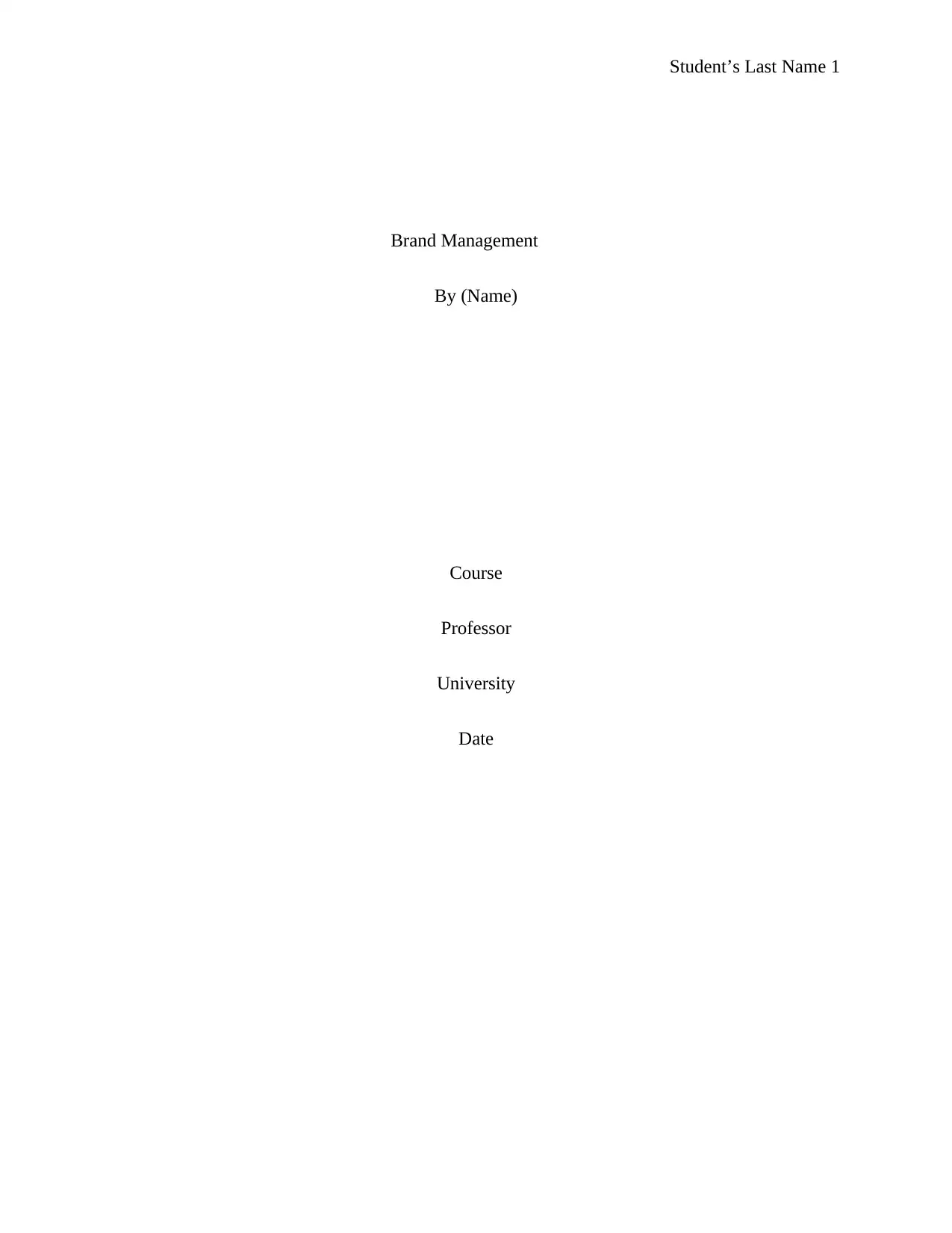
Student’s Last Name 1
Brand Management
By (Name)
Course
Professor
University
Date
Brand Management
By (Name)
Course
Professor
University
Date
Secure Best Marks with AI Grader
Need help grading? Try our AI Grader for instant feedback on your assignments.
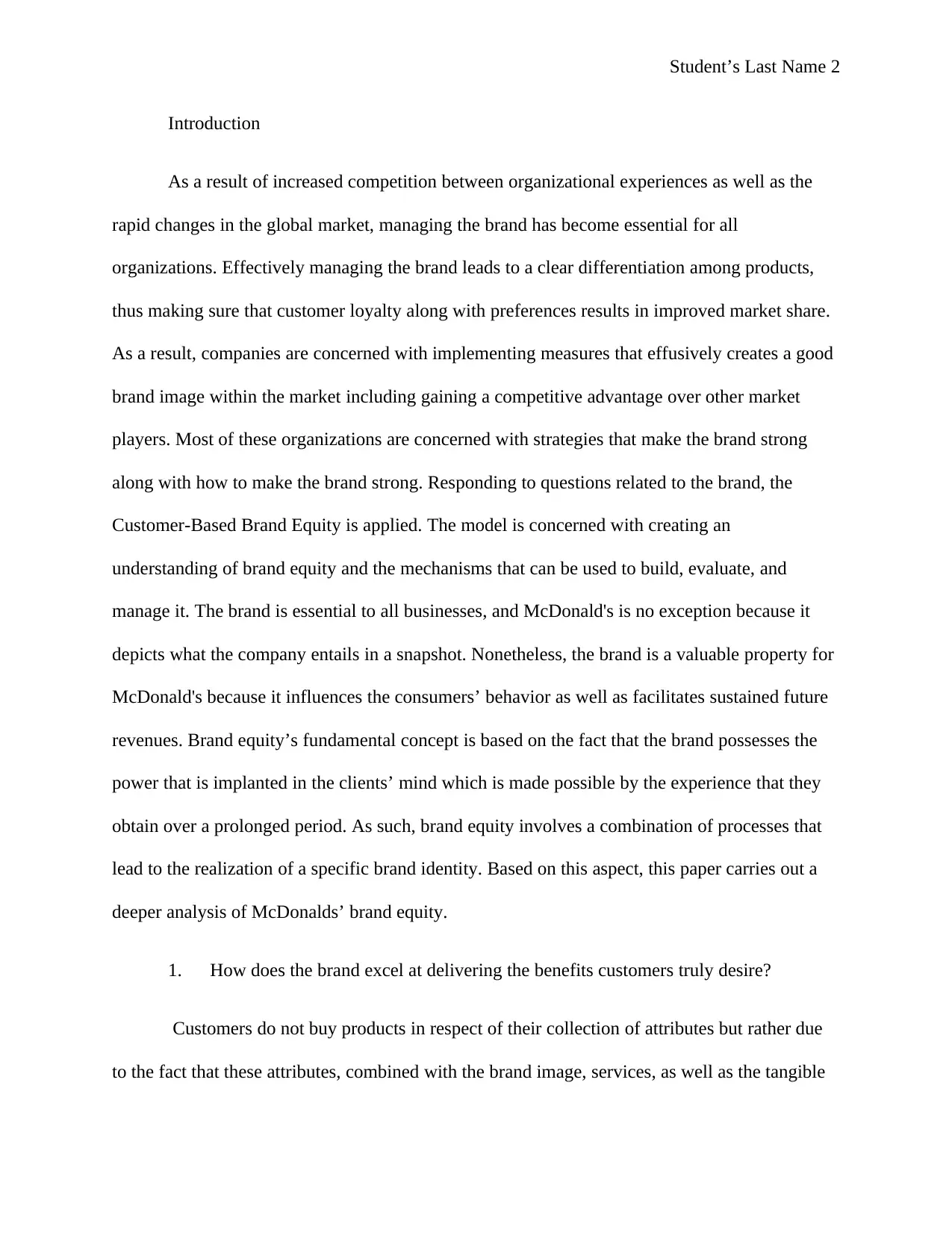
Student’s Last Name 2
Introduction
As a result of increased competition between organizational experiences as well as the
rapid changes in the global market, managing the brand has become essential for all
organizations. Effectively managing the brand leads to a clear differentiation among products,
thus making sure that customer loyalty along with preferences results in improved market share.
As a result, companies are concerned with implementing measures that effusively creates a good
brand image within the market including gaining a competitive advantage over other market
players. Most of these organizations are concerned with strategies that make the brand strong
along with how to make the brand strong. Responding to questions related to the brand, the
Customer-Based Brand Equity is applied. The model is concerned with creating an
understanding of brand equity and the mechanisms that can be used to build, evaluate, and
manage it. The brand is essential to all businesses, and McDonald's is no exception because it
depicts what the company entails in a snapshot. Nonetheless, the brand is a valuable property for
McDonald's because it influences the consumers’ behavior as well as facilitates sustained future
revenues. Brand equity’s fundamental concept is based on the fact that the brand possesses the
power that is implanted in the clients’ mind which is made possible by the experience that they
obtain over a prolonged period. As such, brand equity involves a combination of processes that
lead to the realization of a specific brand identity. Based on this aspect, this paper carries out a
deeper analysis of McDonalds’ brand equity.
1. How does the brand excel at delivering the benefits customers truly desire?
Customers do not buy products in respect of their collection of attributes but rather due
to the fact that these attributes, combined with the brand image, services, as well as the tangible
Introduction
As a result of increased competition between organizational experiences as well as the
rapid changes in the global market, managing the brand has become essential for all
organizations. Effectively managing the brand leads to a clear differentiation among products,
thus making sure that customer loyalty along with preferences results in improved market share.
As a result, companies are concerned with implementing measures that effusively creates a good
brand image within the market including gaining a competitive advantage over other market
players. Most of these organizations are concerned with strategies that make the brand strong
along with how to make the brand strong. Responding to questions related to the brand, the
Customer-Based Brand Equity is applied. The model is concerned with creating an
understanding of brand equity and the mechanisms that can be used to build, evaluate, and
manage it. The brand is essential to all businesses, and McDonald's is no exception because it
depicts what the company entails in a snapshot. Nonetheless, the brand is a valuable property for
McDonald's because it influences the consumers’ behavior as well as facilitates sustained future
revenues. Brand equity’s fundamental concept is based on the fact that the brand possesses the
power that is implanted in the clients’ mind which is made possible by the experience that they
obtain over a prolonged period. As such, brand equity involves a combination of processes that
lead to the realization of a specific brand identity. Based on this aspect, this paper carries out a
deeper analysis of McDonalds’ brand equity.
1. How does the brand excel at delivering the benefits customers truly desire?
Customers do not buy products in respect of their collection of attributes but rather due
to the fact that these attributes, combined with the brand image, services, as well as the tangible
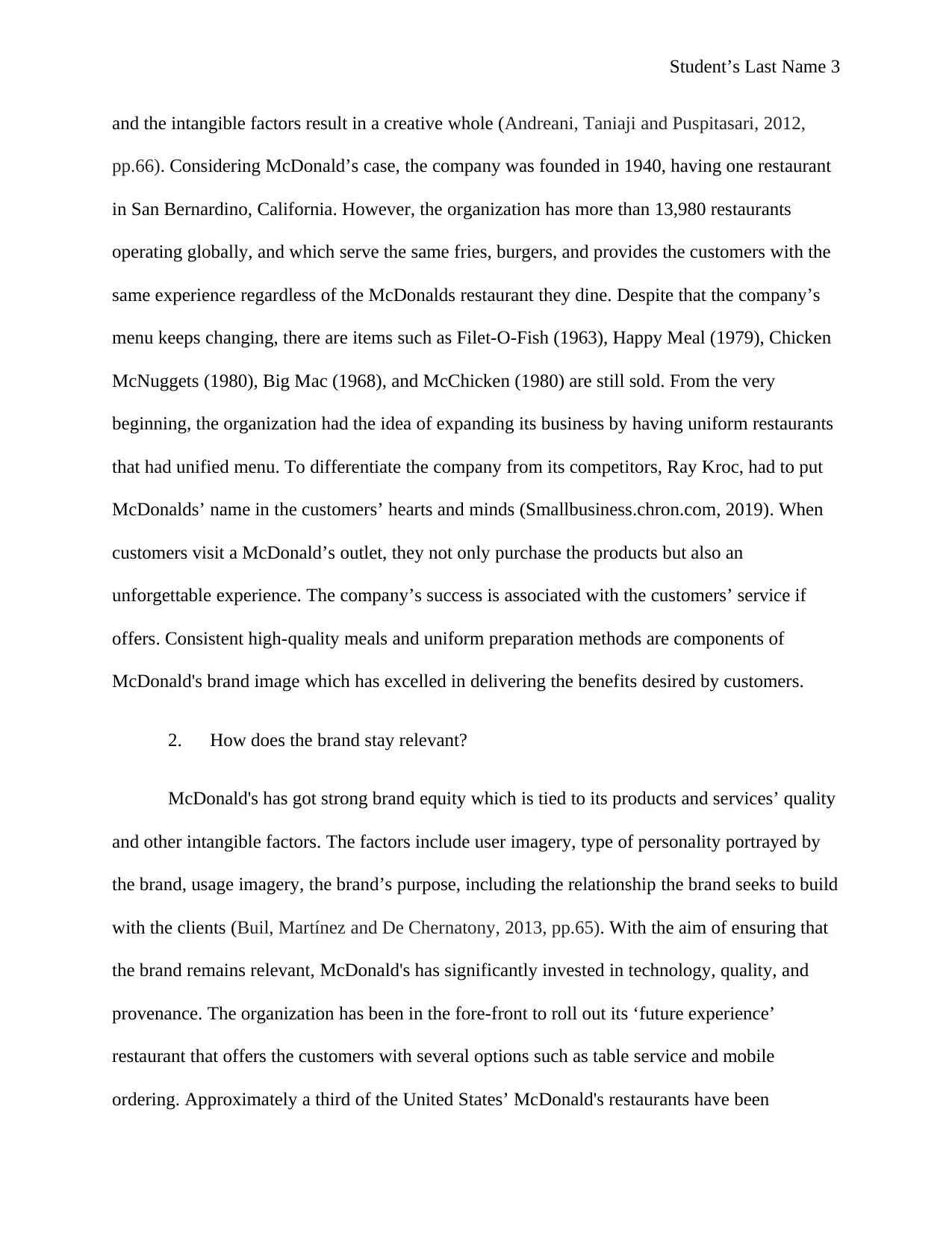
Student’s Last Name 3
and the intangible factors result in a creative whole (Andreani, Taniaji and Puspitasari, 2012,
pp.66). Considering McDonald’s case, the company was founded in 1940, having one restaurant
in San Bernardino, California. However, the organization has more than 13,980 restaurants
operating globally, and which serve the same fries, burgers, and provides the customers with the
same experience regardless of the McDonalds restaurant they dine. Despite that the company’s
menu keeps changing, there are items such as Filet-O-Fish (1963), Happy Meal (1979), Chicken
McNuggets (1980), Big Mac (1968), and McChicken (1980) are still sold. From the very
beginning, the organization had the idea of expanding its business by having uniform restaurants
that had unified menu. To differentiate the company from its competitors, Ray Kroc, had to put
McDonalds’ name in the customers’ hearts and minds (Smallbusiness.chron.com, 2019). When
customers visit a McDonald’s outlet, they not only purchase the products but also an
unforgettable experience. The company’s success is associated with the customers’ service if
offers. Consistent high-quality meals and uniform preparation methods are components of
McDonald's brand image which has excelled in delivering the benefits desired by customers.
2. How does the brand stay relevant?
McDonald's has got strong brand equity which is tied to its products and services’ quality
and other intangible factors. The factors include user imagery, type of personality portrayed by
the brand, usage imagery, the brand’s purpose, including the relationship the brand seeks to build
with the clients (Buil, Martínez and De Chernatony, 2013, pp.65). With the aim of ensuring that
the brand remains relevant, McDonald's has significantly invested in technology, quality, and
provenance. The organization has been in the fore-front to roll out its ‘future experience’
restaurant that offers the customers with several options such as table service and mobile
ordering. Approximately a third of the United States’ McDonald's restaurants have been
and the intangible factors result in a creative whole (Andreani, Taniaji and Puspitasari, 2012,
pp.66). Considering McDonald’s case, the company was founded in 1940, having one restaurant
in San Bernardino, California. However, the organization has more than 13,980 restaurants
operating globally, and which serve the same fries, burgers, and provides the customers with the
same experience regardless of the McDonalds restaurant they dine. Despite that the company’s
menu keeps changing, there are items such as Filet-O-Fish (1963), Happy Meal (1979), Chicken
McNuggets (1980), Big Mac (1968), and McChicken (1980) are still sold. From the very
beginning, the organization had the idea of expanding its business by having uniform restaurants
that had unified menu. To differentiate the company from its competitors, Ray Kroc, had to put
McDonalds’ name in the customers’ hearts and minds (Smallbusiness.chron.com, 2019). When
customers visit a McDonald’s outlet, they not only purchase the products but also an
unforgettable experience. The company’s success is associated with the customers’ service if
offers. Consistent high-quality meals and uniform preparation methods are components of
McDonald's brand image which has excelled in delivering the benefits desired by customers.
2. How does the brand stay relevant?
McDonald's has got strong brand equity which is tied to its products and services’ quality
and other intangible factors. The factors include user imagery, type of personality portrayed by
the brand, usage imagery, the brand’s purpose, including the relationship the brand seeks to build
with the clients (Buil, Martínez and De Chernatony, 2013, pp.65). With the aim of ensuring that
the brand remains relevant, McDonald's has significantly invested in technology, quality, and
provenance. The organization has been in the fore-front to roll out its ‘future experience’
restaurant that offers the customers with several options such as table service and mobile
ordering. Approximately a third of the United States’ McDonald's restaurants have been
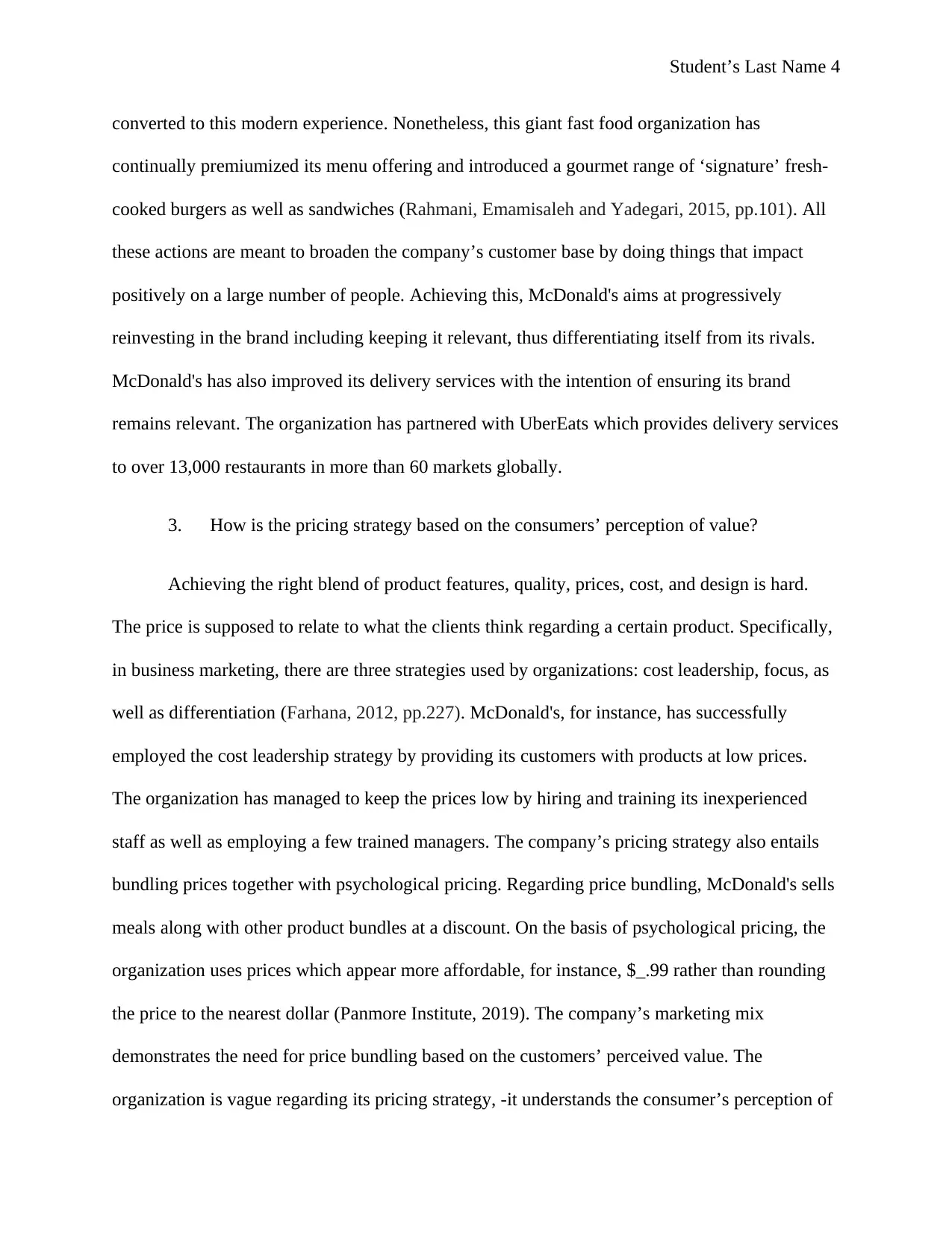
Student’s Last Name 4
converted to this modern experience. Nonetheless, this giant fast food organization has
continually premiumized its menu offering and introduced a gourmet range of ‘signature’ fresh-
cooked burgers as well as sandwiches (Rahmani, Emamisaleh and Yadegari, 2015, pp.101). All
these actions are meant to broaden the company’s customer base by doing things that impact
positively on a large number of people. Achieving this, McDonald's aims at progressively
reinvesting in the brand including keeping it relevant, thus differentiating itself from its rivals.
McDonald's has also improved its delivery services with the intention of ensuring its brand
remains relevant. The organization has partnered with UberEats which provides delivery services
to over 13,000 restaurants in more than 60 markets globally.
3. How is the pricing strategy based on the consumers’ perception of value?
Achieving the right blend of product features, quality, prices, cost, and design is hard.
The price is supposed to relate to what the clients think regarding a certain product. Specifically,
in business marketing, there are three strategies used by organizations: cost leadership, focus, as
well as differentiation (Farhana, 2012, pp.227). McDonald's, for instance, has successfully
employed the cost leadership strategy by providing its customers with products at low prices.
The organization has managed to keep the prices low by hiring and training its inexperienced
staff as well as employing a few trained managers. The company’s pricing strategy also entails
bundling prices together with psychological pricing. Regarding price bundling, McDonald's sells
meals along with other product bundles at a discount. On the basis of psychological pricing, the
organization uses prices which appear more affordable, for instance, $_.99 rather than rounding
the price to the nearest dollar (Panmore Institute, 2019). The company’s marketing mix
demonstrates the need for price bundling based on the customers’ perceived value. The
organization is vague regarding its pricing strategy, -it understands the consumer’s perception of
converted to this modern experience. Nonetheless, this giant fast food organization has
continually premiumized its menu offering and introduced a gourmet range of ‘signature’ fresh-
cooked burgers as well as sandwiches (Rahmani, Emamisaleh and Yadegari, 2015, pp.101). All
these actions are meant to broaden the company’s customer base by doing things that impact
positively on a large number of people. Achieving this, McDonald's aims at progressively
reinvesting in the brand including keeping it relevant, thus differentiating itself from its rivals.
McDonald's has also improved its delivery services with the intention of ensuring its brand
remains relevant. The organization has partnered with UberEats which provides delivery services
to over 13,000 restaurants in more than 60 markets globally.
3. How is the pricing strategy based on the consumers’ perception of value?
Achieving the right blend of product features, quality, prices, cost, and design is hard.
The price is supposed to relate to what the clients think regarding a certain product. Specifically,
in business marketing, there are three strategies used by organizations: cost leadership, focus, as
well as differentiation (Farhana, 2012, pp.227). McDonald's, for instance, has successfully
employed the cost leadership strategy by providing its customers with products at low prices.
The organization has managed to keep the prices low by hiring and training its inexperienced
staff as well as employing a few trained managers. The company’s pricing strategy also entails
bundling prices together with psychological pricing. Regarding price bundling, McDonald's sells
meals along with other product bundles at a discount. On the basis of psychological pricing, the
organization uses prices which appear more affordable, for instance, $_.99 rather than rounding
the price to the nearest dollar (Panmore Institute, 2019). The company’s marketing mix
demonstrates the need for price bundling based on the customers’ perceived value. The
organization is vague regarding its pricing strategy, -it understands the consumer’s perception of
Secure Best Marks with AI Grader
Need help grading? Try our AI Grader for instant feedback on your assignments.
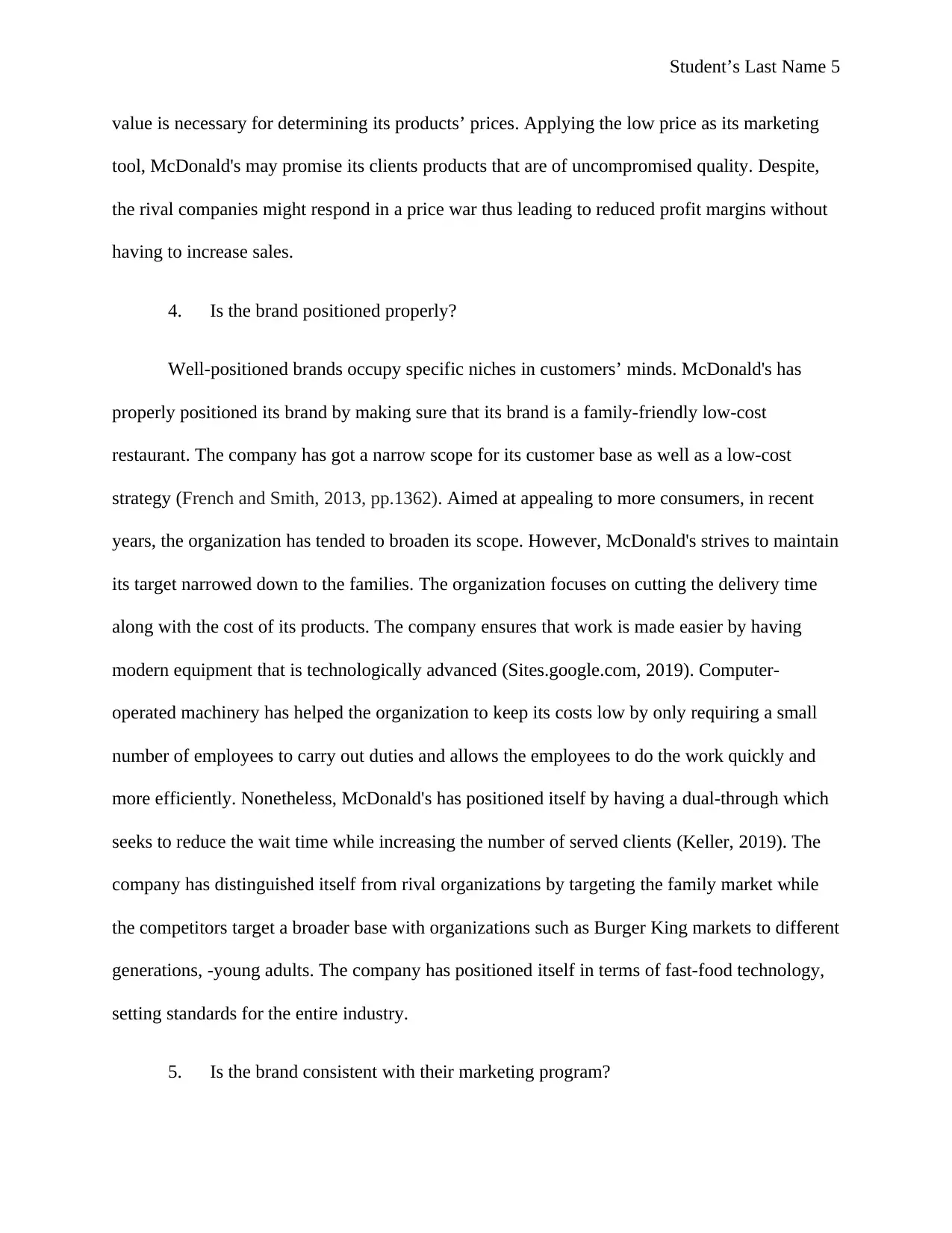
Student’s Last Name 5
value is necessary for determining its products’ prices. Applying the low price as its marketing
tool, McDonald's may promise its clients products that are of uncompromised quality. Despite,
the rival companies might respond in a price war thus leading to reduced profit margins without
having to increase sales.
4. Is the brand positioned properly?
Well-positioned brands occupy specific niches in customers’ minds. McDonald's has
properly positioned its brand by making sure that its brand is a family-friendly low-cost
restaurant. The company has got a narrow scope for its customer base as well as a low-cost
strategy (French and Smith, 2013, pp.1362). Aimed at appealing to more consumers, in recent
years, the organization has tended to broaden its scope. However, McDonald's strives to maintain
its target narrowed down to the families. The organization focuses on cutting the delivery time
along with the cost of its products. The company ensures that work is made easier by having
modern equipment that is technologically advanced (Sites.google.com, 2019). Computer-
operated machinery has helped the organization to keep its costs low by only requiring a small
number of employees to carry out duties and allows the employees to do the work quickly and
more efficiently. Nonetheless, McDonald's has positioned itself by having a dual-through which
seeks to reduce the wait time while increasing the number of served clients (Keller, 2019). The
company has distinguished itself from rival organizations by targeting the family market while
the competitors target a broader base with organizations such as Burger King markets to different
generations, -young adults. The company has positioned itself in terms of fast-food technology,
setting standards for the entire industry.
5. Is the brand consistent with their marketing program?
value is necessary for determining its products’ prices. Applying the low price as its marketing
tool, McDonald's may promise its clients products that are of uncompromised quality. Despite,
the rival companies might respond in a price war thus leading to reduced profit margins without
having to increase sales.
4. Is the brand positioned properly?
Well-positioned brands occupy specific niches in customers’ minds. McDonald's has
properly positioned its brand by making sure that its brand is a family-friendly low-cost
restaurant. The company has got a narrow scope for its customer base as well as a low-cost
strategy (French and Smith, 2013, pp.1362). Aimed at appealing to more consumers, in recent
years, the organization has tended to broaden its scope. However, McDonald's strives to maintain
its target narrowed down to the families. The organization focuses on cutting the delivery time
along with the cost of its products. The company ensures that work is made easier by having
modern equipment that is technologically advanced (Sites.google.com, 2019). Computer-
operated machinery has helped the organization to keep its costs low by only requiring a small
number of employees to carry out duties and allows the employees to do the work quickly and
more efficiently. Nonetheless, McDonald's has positioned itself by having a dual-through which
seeks to reduce the wait time while increasing the number of served clients (Keller, 2019). The
company has distinguished itself from rival organizations by targeting the family market while
the competitors target a broader base with organizations such as Burger King markets to different
generations, -young adults. The company has positioned itself in terms of fast-food technology,
setting standards for the entire industry.
5. Is the brand consistent with their marketing program?
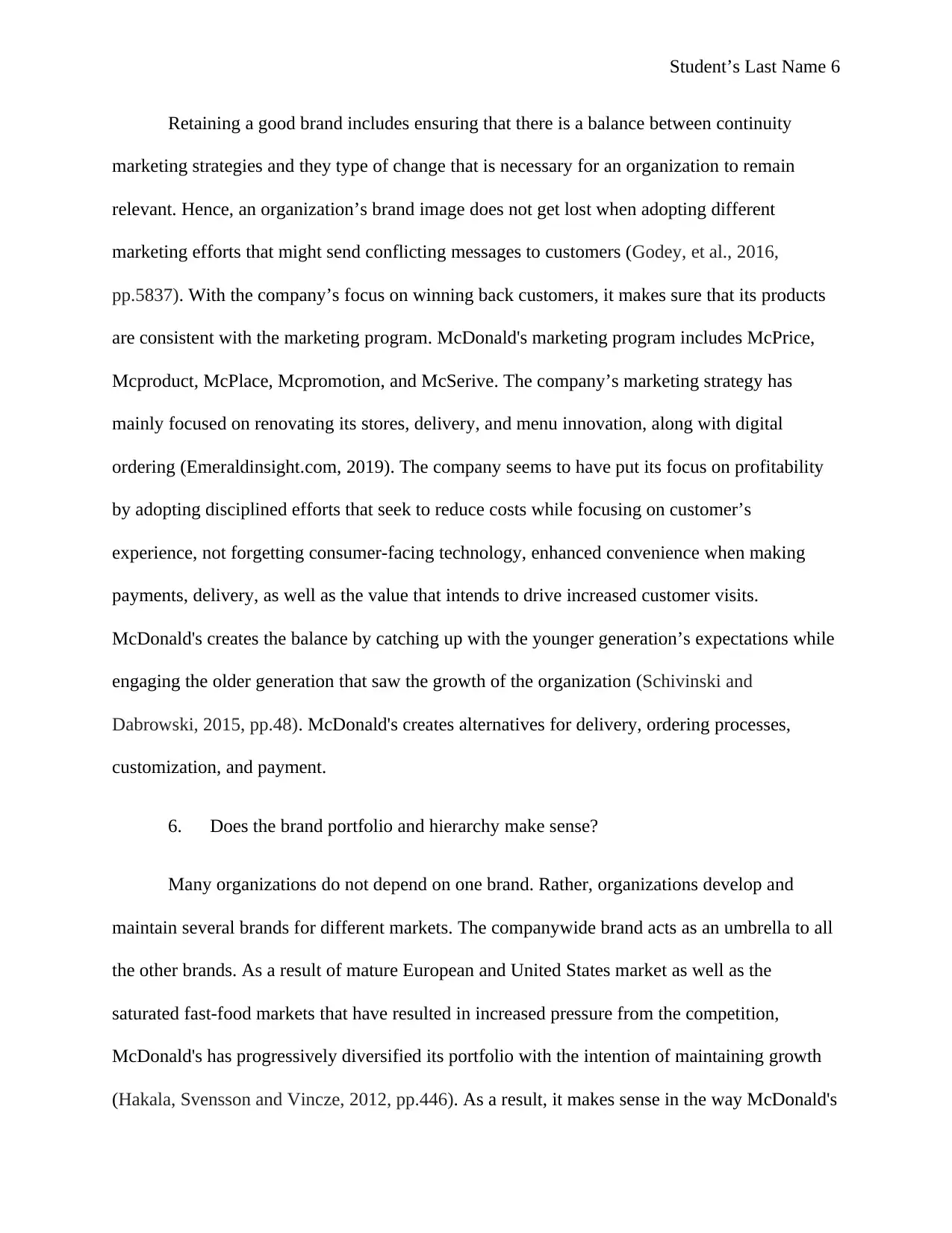
Student’s Last Name 6
Retaining a good brand includes ensuring that there is a balance between continuity
marketing strategies and they type of change that is necessary for an organization to remain
relevant. Hence, an organization’s brand image does not get lost when adopting different
marketing efforts that might send conflicting messages to customers (Godey, et al., 2016,
pp.5837). With the company’s focus on winning back customers, it makes sure that its products
are consistent with the marketing program. McDonald's marketing program includes McPrice,
Mcproduct, McPlace, Mcpromotion, and McSerive. The company’s marketing strategy has
mainly focused on renovating its stores, delivery, and menu innovation, along with digital
ordering (Emeraldinsight.com, 2019). The company seems to have put its focus on profitability
by adopting disciplined efforts that seek to reduce costs while focusing on customer’s
experience, not forgetting consumer-facing technology, enhanced convenience when making
payments, delivery, as well as the value that intends to drive increased customer visits.
McDonald's creates the balance by catching up with the younger generation’s expectations while
engaging the older generation that saw the growth of the organization (Schivinski and
Dabrowski, 2015, pp.48). McDonald's creates alternatives for delivery, ordering processes,
customization, and payment.
6. Does the brand portfolio and hierarchy make sense?
Many organizations do not depend on one brand. Rather, organizations develop and
maintain several brands for different markets. The companywide brand acts as an umbrella to all
the other brands. As a result of mature European and United States market as well as the
saturated fast-food markets that have resulted in increased pressure from the competition,
McDonald's has progressively diversified its portfolio with the intention of maintaining growth
(Hakala, Svensson and Vincze, 2012, pp.446). As a result, it makes sense in the way McDonald's
Retaining a good brand includes ensuring that there is a balance between continuity
marketing strategies and they type of change that is necessary for an organization to remain
relevant. Hence, an organization’s brand image does not get lost when adopting different
marketing efforts that might send conflicting messages to customers (Godey, et al., 2016,
pp.5837). With the company’s focus on winning back customers, it makes sure that its products
are consistent with the marketing program. McDonald's marketing program includes McPrice,
Mcproduct, McPlace, Mcpromotion, and McSerive. The company’s marketing strategy has
mainly focused on renovating its stores, delivery, and menu innovation, along with digital
ordering (Emeraldinsight.com, 2019). The company seems to have put its focus on profitability
by adopting disciplined efforts that seek to reduce costs while focusing on customer’s
experience, not forgetting consumer-facing technology, enhanced convenience when making
payments, delivery, as well as the value that intends to drive increased customer visits.
McDonald's creates the balance by catching up with the younger generation’s expectations while
engaging the older generation that saw the growth of the organization (Schivinski and
Dabrowski, 2015, pp.48). McDonald's creates alternatives for delivery, ordering processes,
customization, and payment.
6. Does the brand portfolio and hierarchy make sense?
Many organizations do not depend on one brand. Rather, organizations develop and
maintain several brands for different markets. The companywide brand acts as an umbrella to all
the other brands. As a result of mature European and United States market as well as the
saturated fast-food markets that have resulted in increased pressure from the competition,
McDonald's has progressively diversified its portfolio with the intention of maintaining growth
(Hakala, Svensson and Vincze, 2012, pp.446). As a result, it makes sense in the way McDonald's
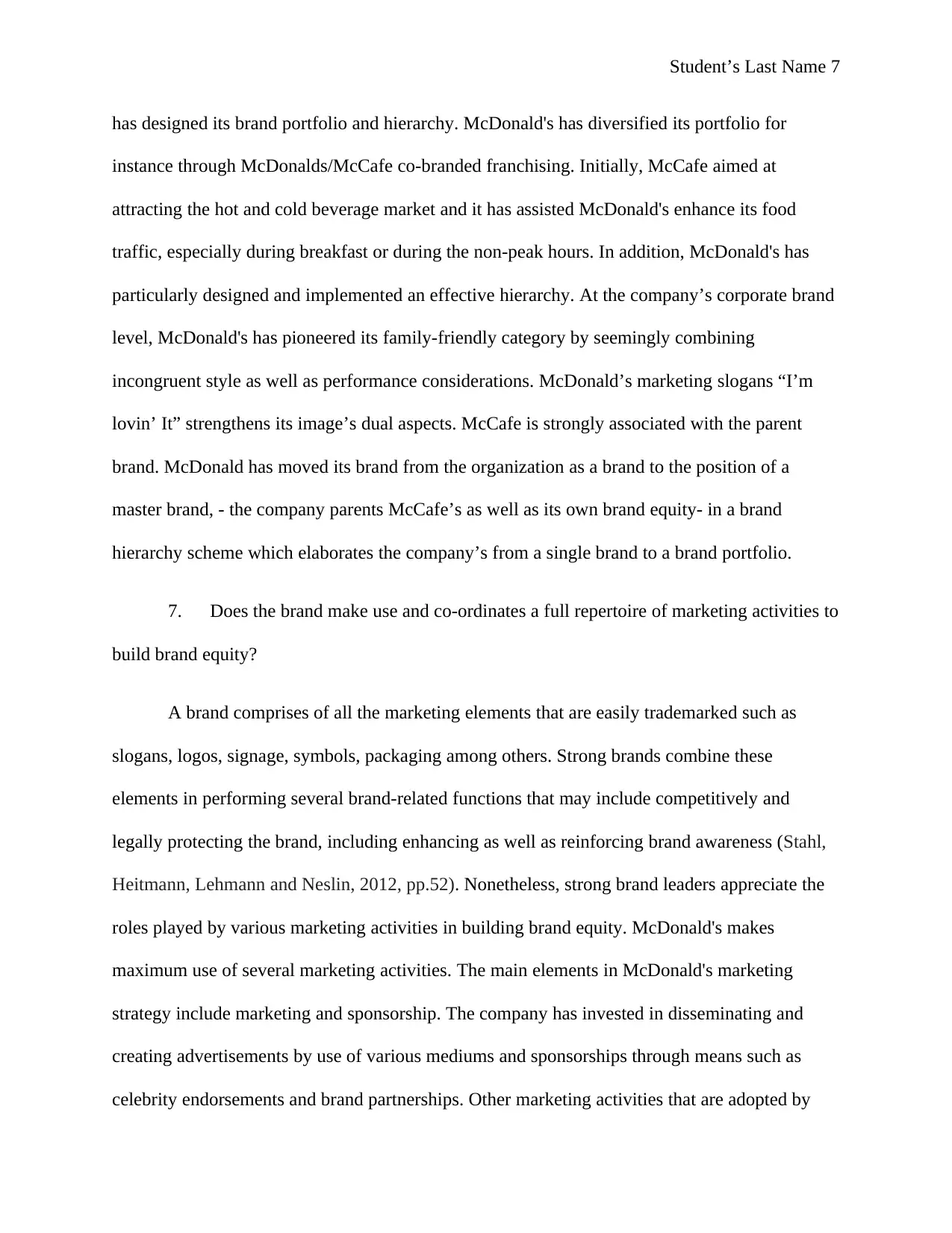
Student’s Last Name 7
has designed its brand portfolio and hierarchy. McDonald's has diversified its portfolio for
instance through McDonalds/McCafe co-branded franchising. Initially, McCafe aimed at
attracting the hot and cold beverage market and it has assisted McDonald's enhance its food
traffic, especially during breakfast or during the non-peak hours. In addition, McDonald's has
particularly designed and implemented an effective hierarchy. At the company’s corporate brand
level, McDonald's has pioneered its family-friendly category by seemingly combining
incongruent style as well as performance considerations. McDonald’s marketing slogans “I’m
lovin’ It” strengthens its image’s dual aspects. McCafe is strongly associated with the parent
brand. McDonald has moved its brand from the organization as a brand to the position of a
master brand, - the company parents McCafe’s as well as its own brand equity- in a brand
hierarchy scheme which elaborates the company’s from a single brand to a brand portfolio.
7. Does the brand make use and co-ordinates a full repertoire of marketing activities to
build brand equity?
A brand comprises of all the marketing elements that are easily trademarked such as
slogans, logos, signage, symbols, packaging among others. Strong brands combine these
elements in performing several brand-related functions that may include competitively and
legally protecting the brand, including enhancing as well as reinforcing brand awareness (Stahl,
Heitmann, Lehmann and Neslin, 2012, pp.52). Nonetheless, strong brand leaders appreciate the
roles played by various marketing activities in building brand equity. McDonald's makes
maximum use of several marketing activities. The main elements in McDonald's marketing
strategy include marketing and sponsorship. The company has invested in disseminating and
creating advertisements by use of various mediums and sponsorships through means such as
celebrity endorsements and brand partnerships. Other marketing activities that are adopted by
has designed its brand portfolio and hierarchy. McDonald's has diversified its portfolio for
instance through McDonalds/McCafe co-branded franchising. Initially, McCafe aimed at
attracting the hot and cold beverage market and it has assisted McDonald's enhance its food
traffic, especially during breakfast or during the non-peak hours. In addition, McDonald's has
particularly designed and implemented an effective hierarchy. At the company’s corporate brand
level, McDonald's has pioneered its family-friendly category by seemingly combining
incongruent style as well as performance considerations. McDonald’s marketing slogans “I’m
lovin’ It” strengthens its image’s dual aspects. McCafe is strongly associated with the parent
brand. McDonald has moved its brand from the organization as a brand to the position of a
master brand, - the company parents McCafe’s as well as its own brand equity- in a brand
hierarchy scheme which elaborates the company’s from a single brand to a brand portfolio.
7. Does the brand make use and co-ordinates a full repertoire of marketing activities to
build brand equity?
A brand comprises of all the marketing elements that are easily trademarked such as
slogans, logos, signage, symbols, packaging among others. Strong brands combine these
elements in performing several brand-related functions that may include competitively and
legally protecting the brand, including enhancing as well as reinforcing brand awareness (Stahl,
Heitmann, Lehmann and Neslin, 2012, pp.52). Nonetheless, strong brand leaders appreciate the
roles played by various marketing activities in building brand equity. McDonald's makes
maximum use of several marketing activities. The main elements in McDonald's marketing
strategy include marketing and sponsorship. The company has invested in disseminating and
creating advertisements by use of various mediums and sponsorships through means such as
celebrity endorsements and brand partnerships. Other marketing activities that are adopted by
Paraphrase This Document
Need a fresh take? Get an instant paraphrase of this document with our AI Paraphraser
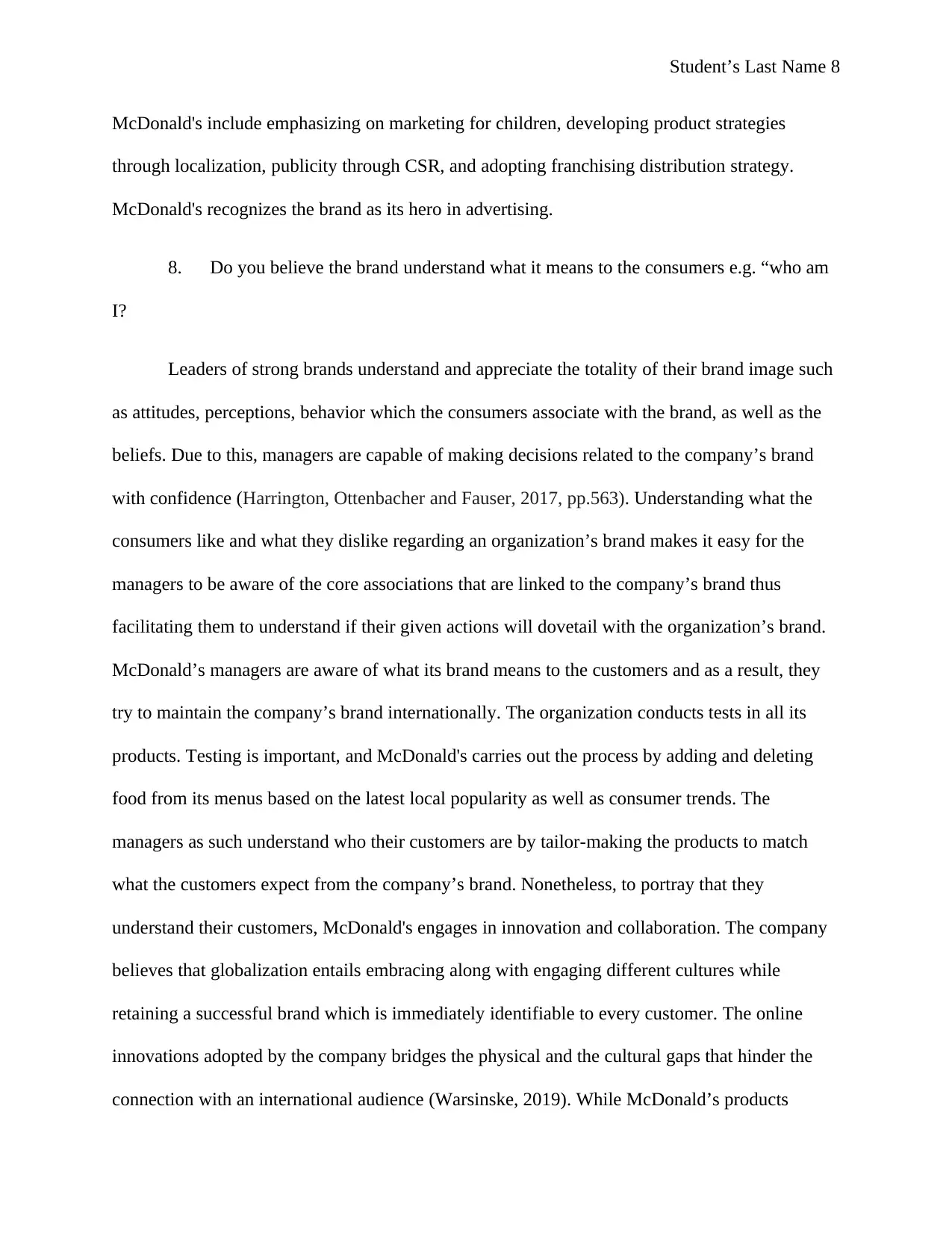
Student’s Last Name 8
McDonald's include emphasizing on marketing for children, developing product strategies
through localization, publicity through CSR, and adopting franchising distribution strategy.
McDonald's recognizes the brand as its hero in advertising.
8. Do you believe the brand understand what it means to the consumers e.g. “who am
I?
Leaders of strong brands understand and appreciate the totality of their brand image such
as attitudes, perceptions, behavior which the consumers associate with the brand, as well as the
beliefs. Due to this, managers are capable of making decisions related to the company’s brand
with confidence (Harrington, Ottenbacher and Fauser, 2017, pp.563). Understanding what the
consumers like and what they dislike regarding an organization’s brand makes it easy for the
managers to be aware of the core associations that are linked to the company’s brand thus
facilitating them to understand if their given actions will dovetail with the organization’s brand.
McDonald’s managers are aware of what its brand means to the customers and as a result, they
try to maintain the company’s brand internationally. The organization conducts tests in all its
products. Testing is important, and McDonald's carries out the process by adding and deleting
food from its menus based on the latest local popularity as well as consumer trends. The
managers as such understand who their customers are by tailor-making the products to match
what the customers expect from the company’s brand. Nonetheless, to portray that they
understand their customers, McDonald's engages in innovation and collaboration. The company
believes that globalization entails embracing along with engaging different cultures while
retaining a successful brand which is immediately identifiable to every customer. The online
innovations adopted by the company bridges the physical and the cultural gaps that hinder the
connection with an international audience (Warsinske, 2019). While McDonald’s products
McDonald's include emphasizing on marketing for children, developing product strategies
through localization, publicity through CSR, and adopting franchising distribution strategy.
McDonald's recognizes the brand as its hero in advertising.
8. Do you believe the brand understand what it means to the consumers e.g. “who am
I?
Leaders of strong brands understand and appreciate the totality of their brand image such
as attitudes, perceptions, behavior which the consumers associate with the brand, as well as the
beliefs. Due to this, managers are capable of making decisions related to the company’s brand
with confidence (Harrington, Ottenbacher and Fauser, 2017, pp.563). Understanding what the
consumers like and what they dislike regarding an organization’s brand makes it easy for the
managers to be aware of the core associations that are linked to the company’s brand thus
facilitating them to understand if their given actions will dovetail with the organization’s brand.
McDonald’s managers are aware of what its brand means to the customers and as a result, they
try to maintain the company’s brand internationally. The organization conducts tests in all its
products. Testing is important, and McDonald's carries out the process by adding and deleting
food from its menus based on the latest local popularity as well as consumer trends. The
managers as such understand who their customers are by tailor-making the products to match
what the customers expect from the company’s brand. Nonetheless, to portray that they
understand their customers, McDonald's engages in innovation and collaboration. The company
believes that globalization entails embracing along with engaging different cultures while
retaining a successful brand which is immediately identifiable to every customer. The online
innovations adopted by the company bridges the physical and the cultural gaps that hinder the
connection with an international audience (Warsinske, 2019). While McDonald’s products
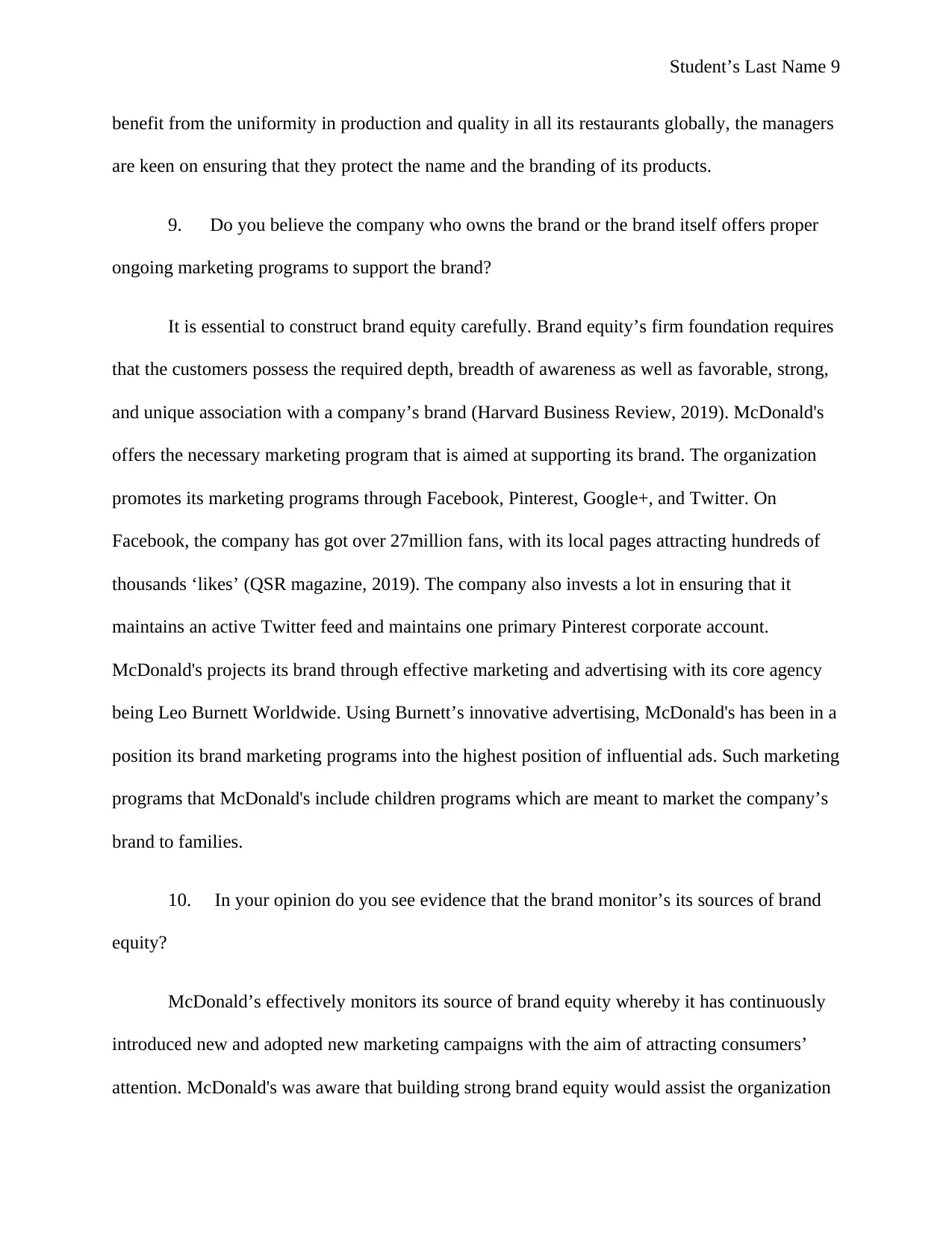
Student’s Last Name 9
benefit from the uniformity in production and quality in all its restaurants globally, the managers
are keen on ensuring that they protect the name and the branding of its products.
9. Do you believe the company who owns the brand or the brand itself offers proper
ongoing marketing programs to support the brand?
It is essential to construct brand equity carefully. Brand equity’s firm foundation requires
that the customers possess the required depth, breadth of awareness as well as favorable, strong,
and unique association with a company’s brand (Harvard Business Review, 2019). McDonald's
offers the necessary marketing program that is aimed at supporting its brand. The organization
promotes its marketing programs through Facebook, Pinterest, Google+, and Twitter. On
Facebook, the company has got over 27million fans, with its local pages attracting hundreds of
thousands ‘likes’ (QSR magazine, 2019). The company also invests a lot in ensuring that it
maintains an active Twitter feed and maintains one primary Pinterest corporate account.
McDonald's projects its brand through effective marketing and advertising with its core agency
being Leo Burnett Worldwide. Using Burnett’s innovative advertising, McDonald's has been in a
position its brand marketing programs into the highest position of influential ads. Such marketing
programs that McDonald's include children programs which are meant to market the company’s
brand to families.
10. In your opinion do you see evidence that the brand monitor’s its sources of brand
equity?
McDonald’s effectively monitors its source of brand equity whereby it has continuously
introduced new and adopted new marketing campaigns with the aim of attracting consumers’
attention. McDonald's was aware that building strong brand equity would assist the organization
benefit from the uniformity in production and quality in all its restaurants globally, the managers
are keen on ensuring that they protect the name and the branding of its products.
9. Do you believe the company who owns the brand or the brand itself offers proper
ongoing marketing programs to support the brand?
It is essential to construct brand equity carefully. Brand equity’s firm foundation requires
that the customers possess the required depth, breadth of awareness as well as favorable, strong,
and unique association with a company’s brand (Harvard Business Review, 2019). McDonald's
offers the necessary marketing program that is aimed at supporting its brand. The organization
promotes its marketing programs through Facebook, Pinterest, Google+, and Twitter. On
Facebook, the company has got over 27million fans, with its local pages attracting hundreds of
thousands ‘likes’ (QSR magazine, 2019). The company also invests a lot in ensuring that it
maintains an active Twitter feed and maintains one primary Pinterest corporate account.
McDonald's projects its brand through effective marketing and advertising with its core agency
being Leo Burnett Worldwide. Using Burnett’s innovative advertising, McDonald's has been in a
position its brand marketing programs into the highest position of influential ads. Such marketing
programs that McDonald's include children programs which are meant to market the company’s
brand to families.
10. In your opinion do you see evidence that the brand monitor’s its sources of brand
equity?
McDonald’s effectively monitors its source of brand equity whereby it has continuously
introduced new and adopted new marketing campaigns with the aim of attracting consumers’
attention. McDonald's was aware that building strong brand equity would assist the organization
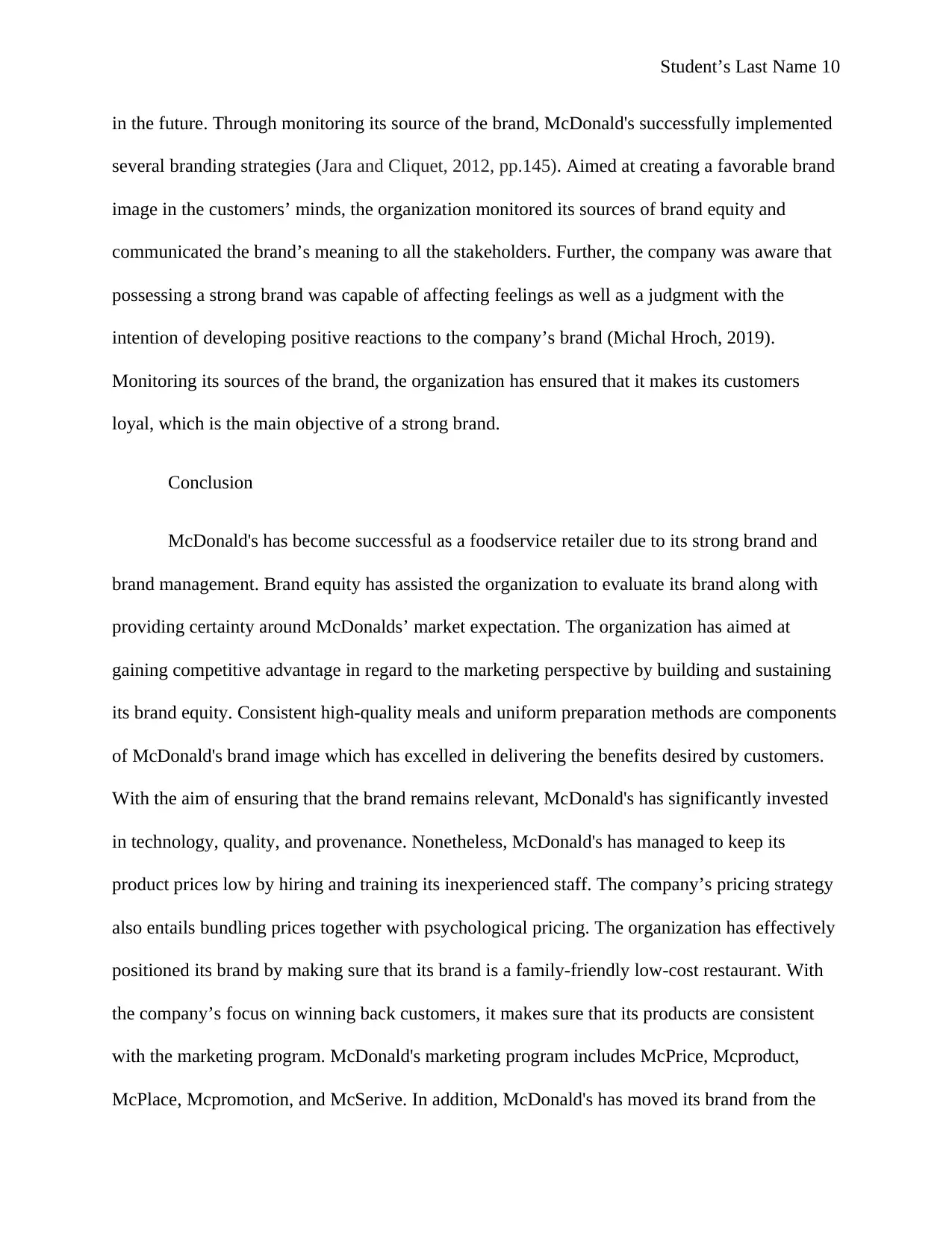
Student’s Last Name 10
in the future. Through monitoring its source of the brand, McDonald's successfully implemented
several branding strategies (Jara and Cliquet, 2012, pp.145). Aimed at creating a favorable brand
image in the customers’ minds, the organization monitored its sources of brand equity and
communicated the brand’s meaning to all the stakeholders. Further, the company was aware that
possessing a strong brand was capable of affecting feelings as well as a judgment with the
intention of developing positive reactions to the company’s brand (Michal Hroch, 2019).
Monitoring its sources of the brand, the organization has ensured that it makes its customers
loyal, which is the main objective of a strong brand.
Conclusion
McDonald's has become successful as a foodservice retailer due to its strong brand and
brand management. Brand equity has assisted the organization to evaluate its brand along with
providing certainty around McDonalds’ market expectation. The organization has aimed at
gaining competitive advantage in regard to the marketing perspective by building and sustaining
its brand equity. Consistent high-quality meals and uniform preparation methods are components
of McDonald's brand image which has excelled in delivering the benefits desired by customers.
With the aim of ensuring that the brand remains relevant, McDonald's has significantly invested
in technology, quality, and provenance. Nonetheless, McDonald's has managed to keep its
product prices low by hiring and training its inexperienced staff. The company’s pricing strategy
also entails bundling prices together with psychological pricing. The organization has effectively
positioned its brand by making sure that its brand is a family-friendly low-cost restaurant. With
the company’s focus on winning back customers, it makes sure that its products are consistent
with the marketing program. McDonald's marketing program includes McPrice, Mcproduct,
McPlace, Mcpromotion, and McSerive. In addition, McDonald's has moved its brand from the
in the future. Through monitoring its source of the brand, McDonald's successfully implemented
several branding strategies (Jara and Cliquet, 2012, pp.145). Aimed at creating a favorable brand
image in the customers’ minds, the organization monitored its sources of brand equity and
communicated the brand’s meaning to all the stakeholders. Further, the company was aware that
possessing a strong brand was capable of affecting feelings as well as a judgment with the
intention of developing positive reactions to the company’s brand (Michal Hroch, 2019).
Monitoring its sources of the brand, the organization has ensured that it makes its customers
loyal, which is the main objective of a strong brand.
Conclusion
McDonald's has become successful as a foodservice retailer due to its strong brand and
brand management. Brand equity has assisted the organization to evaluate its brand along with
providing certainty around McDonalds’ market expectation. The organization has aimed at
gaining competitive advantage in regard to the marketing perspective by building and sustaining
its brand equity. Consistent high-quality meals and uniform preparation methods are components
of McDonald's brand image which has excelled in delivering the benefits desired by customers.
With the aim of ensuring that the brand remains relevant, McDonald's has significantly invested
in technology, quality, and provenance. Nonetheless, McDonald's has managed to keep its
product prices low by hiring and training its inexperienced staff. The company’s pricing strategy
also entails bundling prices together with psychological pricing. The organization has effectively
positioned its brand by making sure that its brand is a family-friendly low-cost restaurant. With
the company’s focus on winning back customers, it makes sure that its products are consistent
with the marketing program. McDonald's marketing program includes McPrice, Mcproduct,
McPlace, Mcpromotion, and McSerive. In addition, McDonald's has moved its brand from the
Secure Best Marks with AI Grader
Need help grading? Try our AI Grader for instant feedback on your assignments.
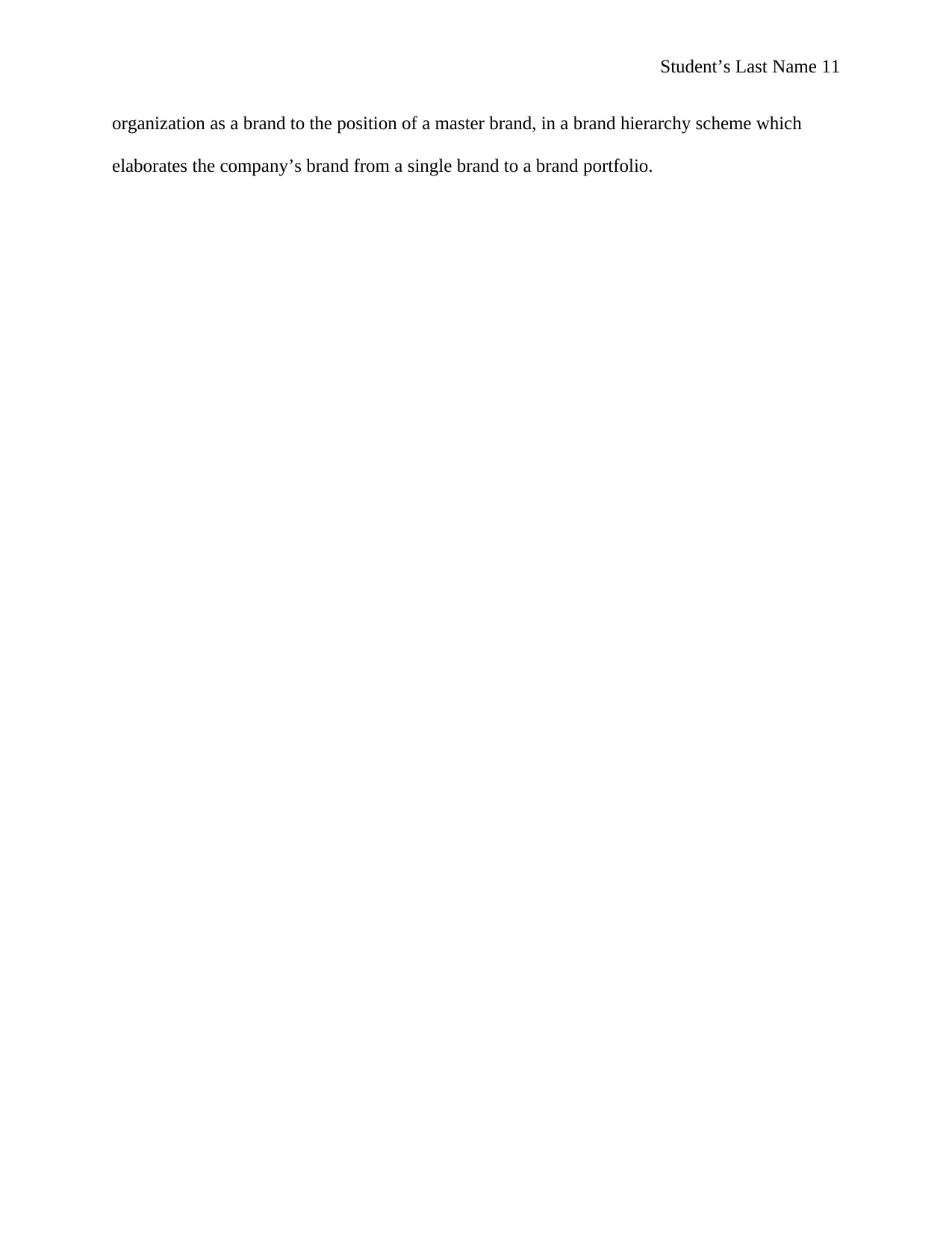
Student’s Last Name 11
organization as a brand to the position of a master brand, in a brand hierarchy scheme which
elaborates the company’s brand from a single brand to a brand portfolio.
organization as a brand to the position of a master brand, in a brand hierarchy scheme which
elaborates the company’s brand from a single brand to a brand portfolio.
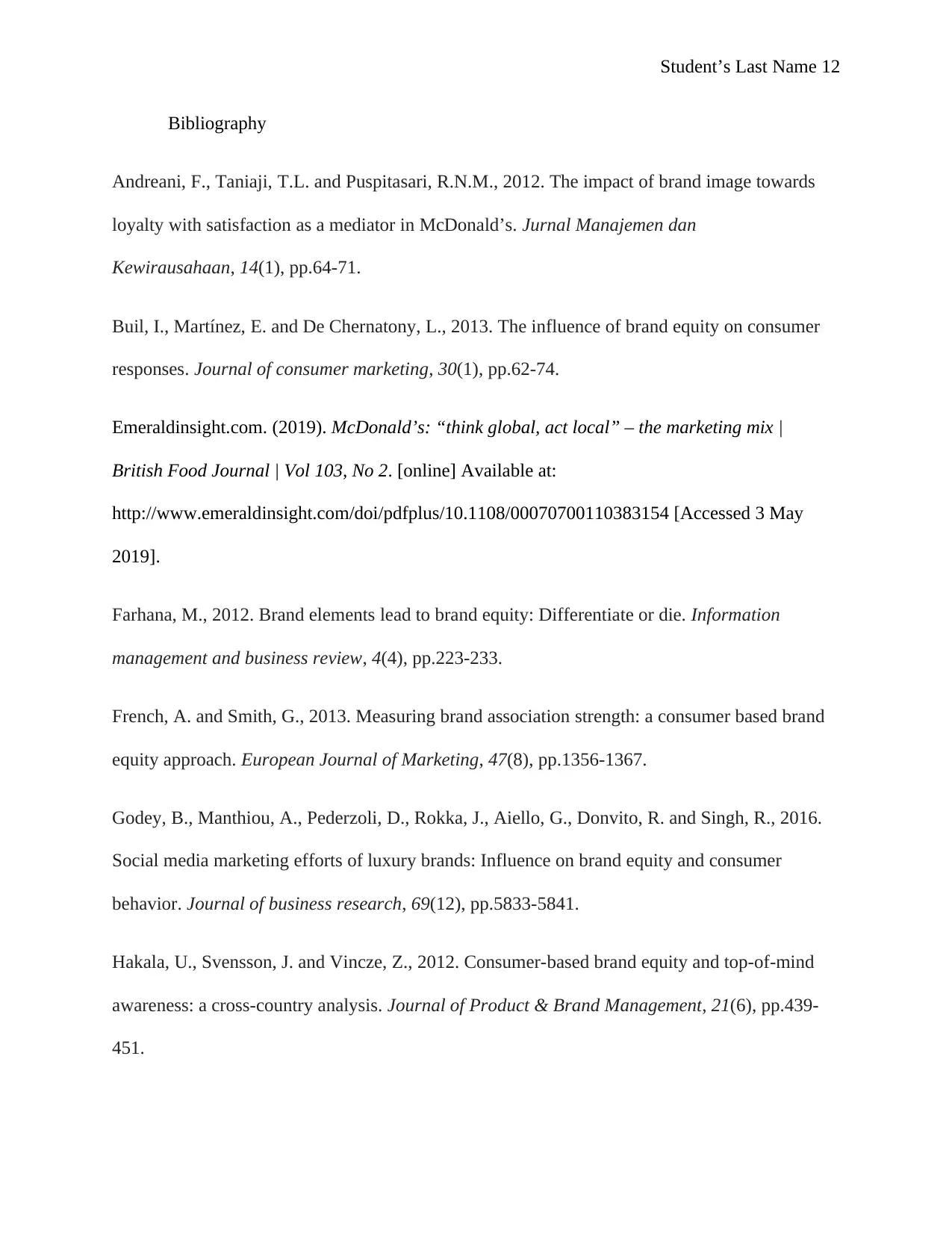
Student’s Last Name 12
Bibliography
Andreani, F., Taniaji, T.L. and Puspitasari, R.N.M., 2012. The impact of brand image towards
loyalty with satisfaction as a mediator in McDonald’s. Jurnal Manajemen dan
Kewirausahaan, 14(1), pp.64-71.
Buil, I., Martínez, E. and De Chernatony, L., 2013. The influence of brand equity on consumer
responses. Journal of consumer marketing, 30(1), pp.62-74.
Emeraldinsight.com. (2019). McDonald’s: “think global, act local” – the marketing mix |
British Food Journal | Vol 103, No 2. [online] Available at:
http://www.emeraldinsight.com/doi/pdfplus/10.1108/00070700110383154 [Accessed 3 May
2019].
Farhana, M., 2012. Brand elements lead to brand equity: Differentiate or die. Information
management and business review, 4(4), pp.223-233.
French, A. and Smith, G., 2013. Measuring brand association strength: a consumer based brand
equity approach. European Journal of Marketing, 47(8), pp.1356-1367.
Godey, B., Manthiou, A., Pederzoli, D., Rokka, J., Aiello, G., Donvito, R. and Singh, R., 2016.
Social media marketing efforts of luxury brands: Influence on brand equity and consumer
behavior. Journal of business research, 69(12), pp.5833-5841.
Hakala, U., Svensson, J. and Vincze, Z., 2012. Consumer-based brand equity and top-of-mind
awareness: a cross-country analysis. Journal of Product & Brand Management, 21(6), pp.439-
451.
Bibliography
Andreani, F., Taniaji, T.L. and Puspitasari, R.N.M., 2012. The impact of brand image towards
loyalty with satisfaction as a mediator in McDonald’s. Jurnal Manajemen dan
Kewirausahaan, 14(1), pp.64-71.
Buil, I., Martínez, E. and De Chernatony, L., 2013. The influence of brand equity on consumer
responses. Journal of consumer marketing, 30(1), pp.62-74.
Emeraldinsight.com. (2019). McDonald’s: “think global, act local” – the marketing mix |
British Food Journal | Vol 103, No 2. [online] Available at:
http://www.emeraldinsight.com/doi/pdfplus/10.1108/00070700110383154 [Accessed 3 May
2019].
Farhana, M., 2012. Brand elements lead to brand equity: Differentiate or die. Information
management and business review, 4(4), pp.223-233.
French, A. and Smith, G., 2013. Measuring brand association strength: a consumer based brand
equity approach. European Journal of Marketing, 47(8), pp.1356-1367.
Godey, B., Manthiou, A., Pederzoli, D., Rokka, J., Aiello, G., Donvito, R. and Singh, R., 2016.
Social media marketing efforts of luxury brands: Influence on brand equity and consumer
behavior. Journal of business research, 69(12), pp.5833-5841.
Hakala, U., Svensson, J. and Vincze, Z., 2012. Consumer-based brand equity and top-of-mind
awareness: a cross-country analysis. Journal of Product & Brand Management, 21(6), pp.439-
451.
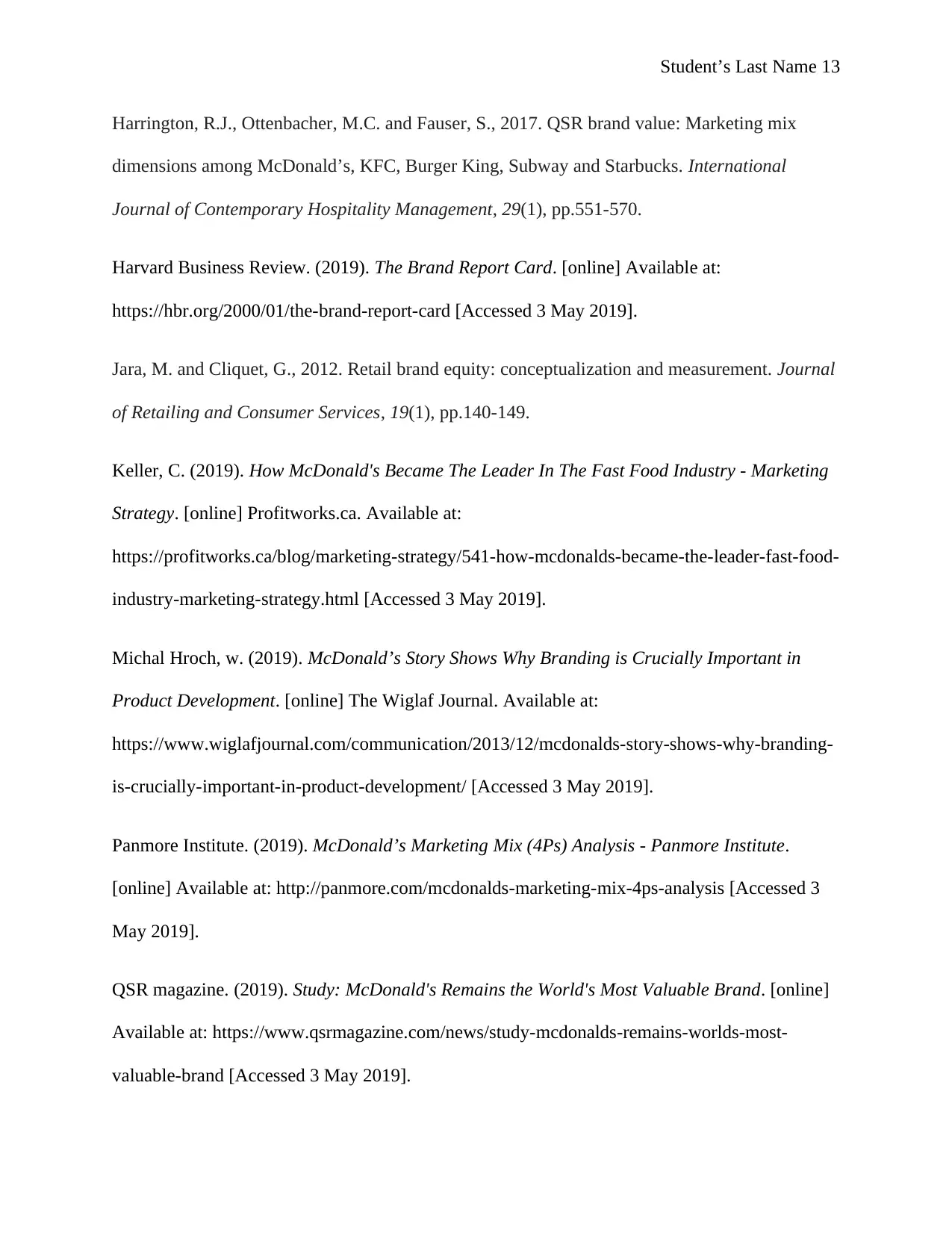
Student’s Last Name 13
Harrington, R.J., Ottenbacher, M.C. and Fauser, S., 2017. QSR brand value: Marketing mix
dimensions among McDonald’s, KFC, Burger King, Subway and Starbucks. International
Journal of Contemporary Hospitality Management, 29(1), pp.551-570.
Harvard Business Review. (2019). The Brand Report Card. [online] Available at:
https://hbr.org/2000/01/the-brand-report-card [Accessed 3 May 2019].
Jara, M. and Cliquet, G., 2012. Retail brand equity: conceptualization and measurement. Journal
of Retailing and Consumer Services, 19(1), pp.140-149.
Keller, C. (2019). How McDonald's Became The Leader In The Fast Food Industry - Marketing
Strategy. [online] Profitworks.ca. Available at:
https://profitworks.ca/blog/marketing-strategy/541-how-mcdonalds-became-the-leader-fast-food-
industry-marketing-strategy.html [Accessed 3 May 2019].
Michal Hroch, w. (2019). McDonald’s Story Shows Why Branding is Crucially Important in
Product Development. [online] The Wiglaf Journal. Available at:
https://www.wiglafjournal.com/communication/2013/12/mcdonalds-story-shows-why-branding-
is-crucially-important-in-product-development/ [Accessed 3 May 2019].
Panmore Institute. (2019). McDonald’s Marketing Mix (4Ps) Analysis - Panmore Institute.
[online] Available at: http://panmore.com/mcdonalds-marketing-mix-4ps-analysis [Accessed 3
May 2019].
QSR magazine. (2019). Study: McDonald's Remains the World's Most Valuable Brand. [online]
Available at: https://www.qsrmagazine.com/news/study-mcdonalds-remains-worlds-most-
valuable-brand [Accessed 3 May 2019].
Harrington, R.J., Ottenbacher, M.C. and Fauser, S., 2017. QSR brand value: Marketing mix
dimensions among McDonald’s, KFC, Burger King, Subway and Starbucks. International
Journal of Contemporary Hospitality Management, 29(1), pp.551-570.
Harvard Business Review. (2019). The Brand Report Card. [online] Available at:
https://hbr.org/2000/01/the-brand-report-card [Accessed 3 May 2019].
Jara, M. and Cliquet, G., 2012. Retail brand equity: conceptualization and measurement. Journal
of Retailing and Consumer Services, 19(1), pp.140-149.
Keller, C. (2019). How McDonald's Became The Leader In The Fast Food Industry - Marketing
Strategy. [online] Profitworks.ca. Available at:
https://profitworks.ca/blog/marketing-strategy/541-how-mcdonalds-became-the-leader-fast-food-
industry-marketing-strategy.html [Accessed 3 May 2019].
Michal Hroch, w. (2019). McDonald’s Story Shows Why Branding is Crucially Important in
Product Development. [online] The Wiglaf Journal. Available at:
https://www.wiglafjournal.com/communication/2013/12/mcdonalds-story-shows-why-branding-
is-crucially-important-in-product-development/ [Accessed 3 May 2019].
Panmore Institute. (2019). McDonald’s Marketing Mix (4Ps) Analysis - Panmore Institute.
[online] Available at: http://panmore.com/mcdonalds-marketing-mix-4ps-analysis [Accessed 3
May 2019].
QSR magazine. (2019). Study: McDonald's Remains the World's Most Valuable Brand. [online]
Available at: https://www.qsrmagazine.com/news/study-mcdonalds-remains-worlds-most-
valuable-brand [Accessed 3 May 2019].
Paraphrase This Document
Need a fresh take? Get an instant paraphrase of this document with our AI Paraphraser
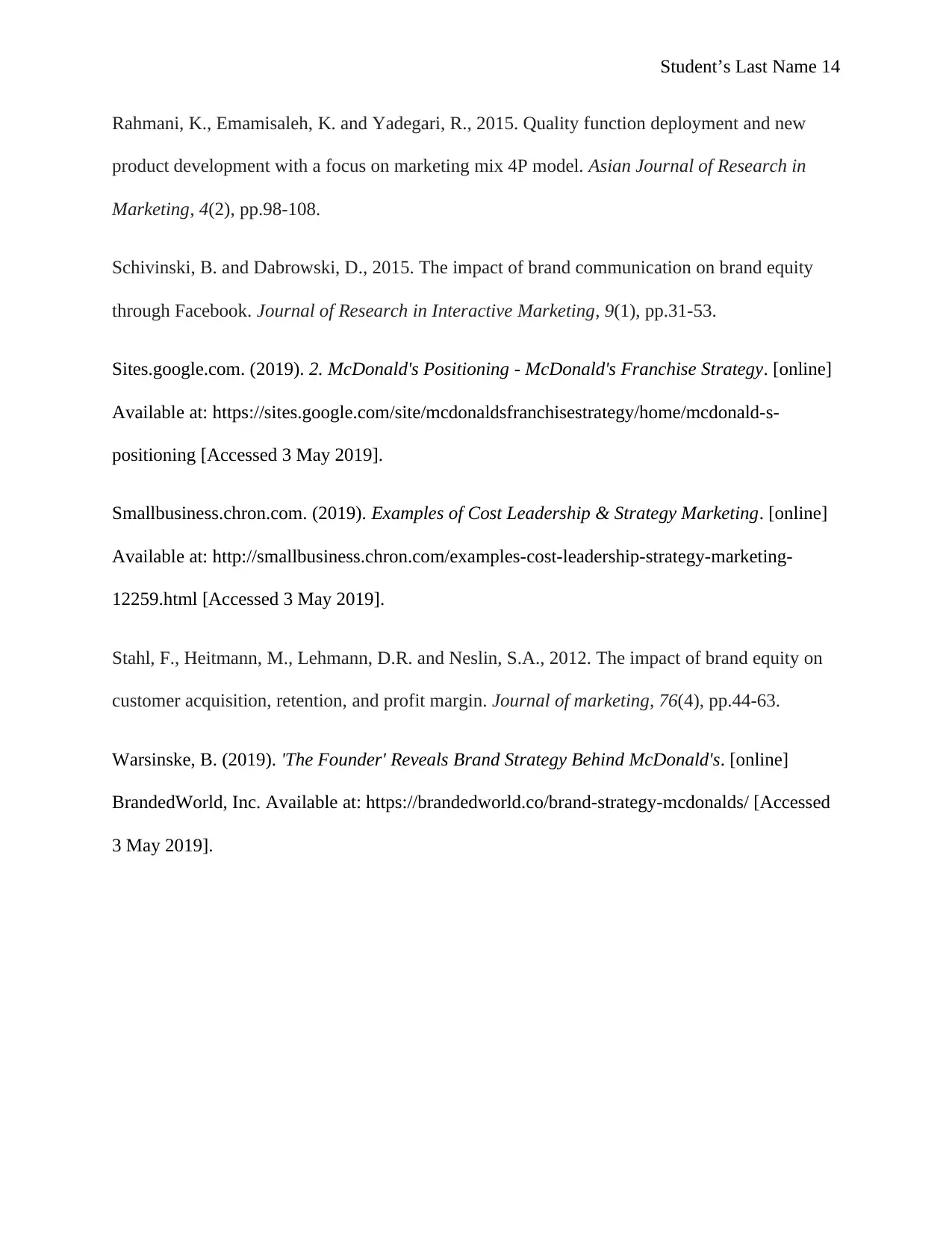
Student’s Last Name 14
Rahmani, K., Emamisaleh, K. and Yadegari, R., 2015. Quality function deployment and new
product development with a focus on marketing mix 4P model. Asian Journal of Research in
Marketing, 4(2), pp.98-108.
Schivinski, B. and Dabrowski, D., 2015. The impact of brand communication on brand equity
through Facebook. Journal of Research in Interactive Marketing, 9(1), pp.31-53.
Sites.google.com. (2019). 2. McDonald's Positioning - McDonald's Franchise Strategy. [online]
Available at: https://sites.google.com/site/mcdonaldsfranchisestrategy/home/mcdonald-s-
positioning [Accessed 3 May 2019].
Smallbusiness.chron.com. (2019). Examples of Cost Leadership & Strategy Marketing. [online]
Available at: http://smallbusiness.chron.com/examples-cost-leadership-strategy-marketing-
12259.html [Accessed 3 May 2019].
Stahl, F., Heitmann, M., Lehmann, D.R. and Neslin, S.A., 2012. The impact of brand equity on
customer acquisition, retention, and profit margin. Journal of marketing, 76(4), pp.44-63.
Warsinske, B. (2019). 'The Founder' Reveals Brand Strategy Behind McDonald's. [online]
BrandedWorld, Inc. Available at: https://brandedworld.co/brand-strategy-mcdonalds/ [Accessed
3 May 2019].
Rahmani, K., Emamisaleh, K. and Yadegari, R., 2015. Quality function deployment and new
product development with a focus on marketing mix 4P model. Asian Journal of Research in
Marketing, 4(2), pp.98-108.
Schivinski, B. and Dabrowski, D., 2015. The impact of brand communication on brand equity
through Facebook. Journal of Research in Interactive Marketing, 9(1), pp.31-53.
Sites.google.com. (2019). 2. McDonald's Positioning - McDonald's Franchise Strategy. [online]
Available at: https://sites.google.com/site/mcdonaldsfranchisestrategy/home/mcdonald-s-
positioning [Accessed 3 May 2019].
Smallbusiness.chron.com. (2019). Examples of Cost Leadership & Strategy Marketing. [online]
Available at: http://smallbusiness.chron.com/examples-cost-leadership-strategy-marketing-
12259.html [Accessed 3 May 2019].
Stahl, F., Heitmann, M., Lehmann, D.R. and Neslin, S.A., 2012. The impact of brand equity on
customer acquisition, retention, and profit margin. Journal of marketing, 76(4), pp.44-63.
Warsinske, B. (2019). 'The Founder' Reveals Brand Strategy Behind McDonald's. [online]
BrandedWorld, Inc. Available at: https://brandedworld.co/brand-strategy-mcdonalds/ [Accessed
3 May 2019].
1 out of 14
Related Documents
Your All-in-One AI-Powered Toolkit for Academic Success.
+13062052269
info@desklib.com
Available 24*7 on WhatsApp / Email
![[object Object]](/_next/static/media/star-bottom.7253800d.svg)
Unlock your academic potential
© 2024 | Zucol Services PVT LTD | All rights reserved.





